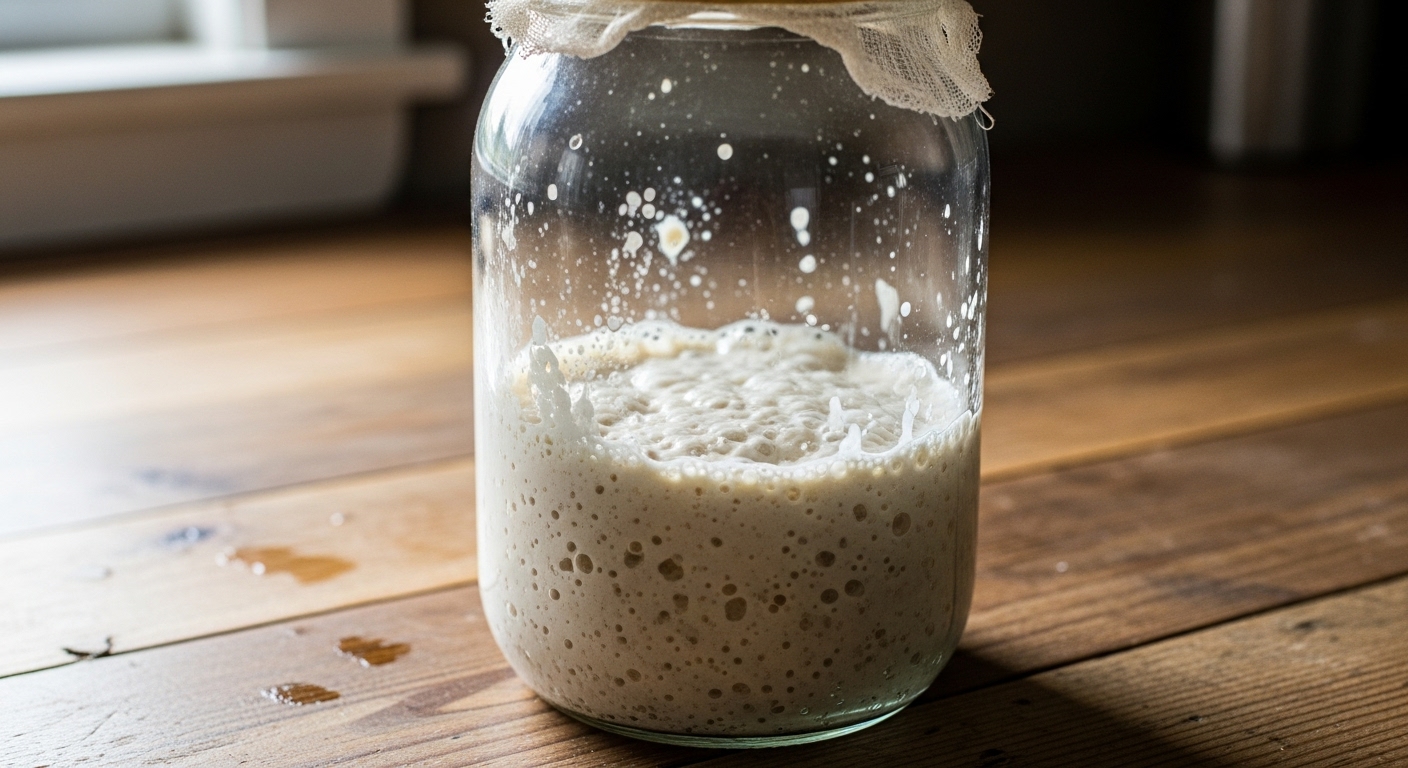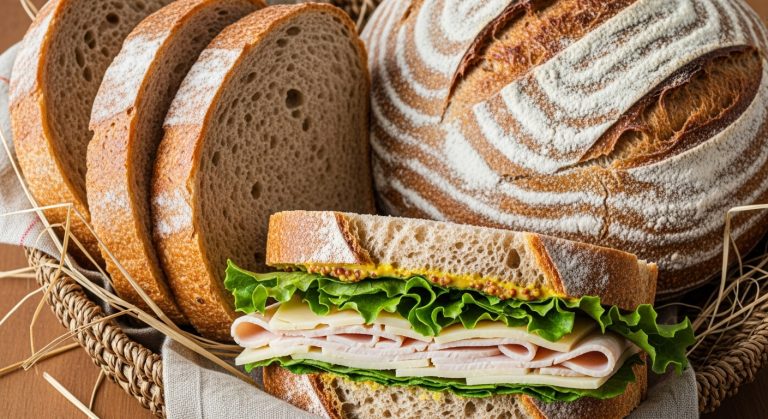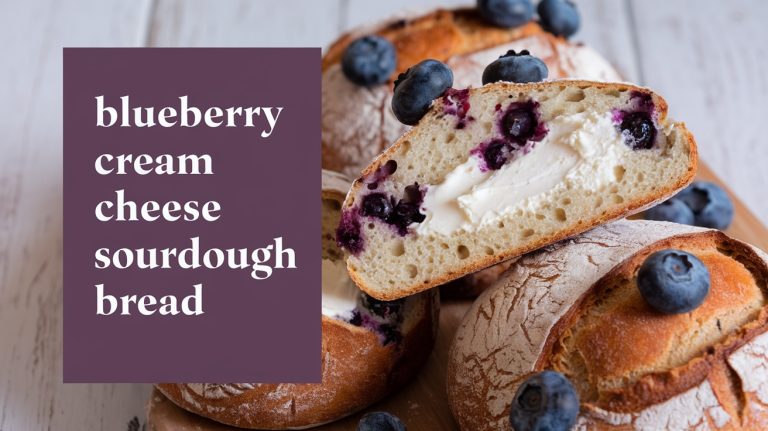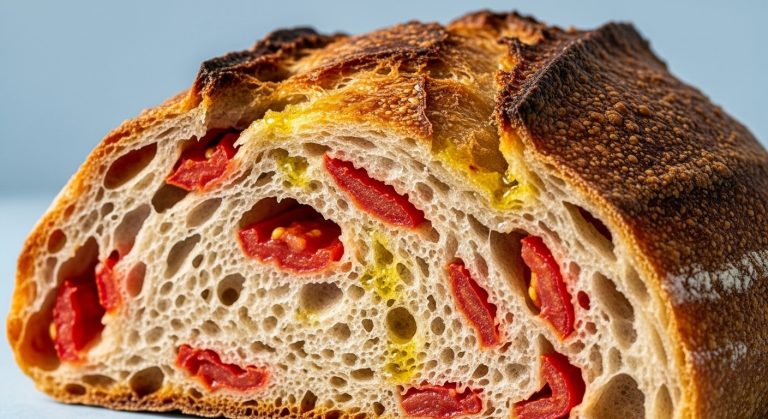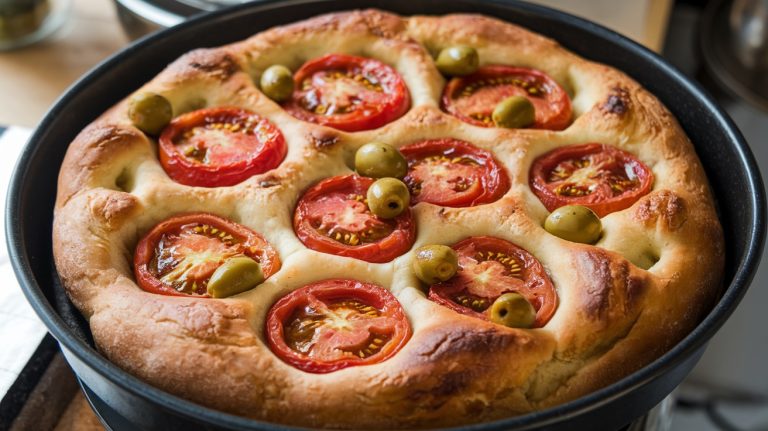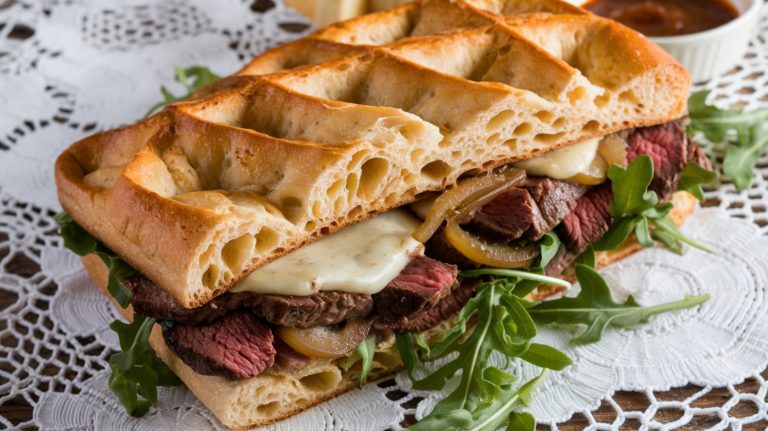What Is Active Sourdough Starter? Learn to Bake Better
An active sourdough starter is your vibrant mix of wild yeasts and lactic acid bacteria working together to ferment flour and water. You’ll see bubbles, a tangy aroma, and a doubled, domed starter indicating it’s ready to leaven bread.
Its hydration impacts how lively and fast it ferments, while feeding and temperature keep those microbes thriving. When your starter reaches peak activity, it’s primed to give your bread that signature rise and flavor.
There’s much more to uncover about nurturing and using this living culture.
Key Takeaways
- An active sourdough starter is a fermented mixture of flour and water containing thriving wild yeasts and lactic acid bacteria.
- It shows visible bubbles, a domed surface, and has roughly doubled in volume, indicating strong microbial fermentation.
- The starter emits a pleasant tangy, yeasty aroma, signaling healthy microbial activity and readiness for baking.
- Active starters typically peak 2–6 hours after feeding, with a light, airy texture and vigorous bubbling throughout.
- Maintaining activity requires regular feedings, consistent temperature (74–80°F), and proper hydration for balanced fermentation.
The Science Behind Sourdough Starter Composition
Although it might seem simple, a sourdough starter hosts a complex, living ecosystem of wild yeasts and lactic acid bacteria working together in harmony.
A sourdough starter is a vibrant ecosystem where wild yeasts and lactic acid bacteria thrive together.
You’ll find yeasts like *Saccharomyces* and *Candida* dancing alongside *Lactobacillus* species, which produce acids that shape the starter’s signature tang. The unique tangy flavor of sourdough is what makes it ideal for recipes like sourdough bread pudding.
Flour and water fuel this dynamic duo—flour provides carbohydrates and native microbes, especially from whole grain or rye varieties, enriching fermentation.
Water quality matters too; chlorine-free, mineral-balanced water supports vibrant microbial growth.
Together, these microbes ferment sugars, releasing carbon dioxide to leaven dough and acids to enhance flavor and shelf life. The starter requires consistent feeding to maintain its vitality and leavening power.
The environment also plays its part, seeding the starter with wild microbes and influencing microbial balance through temperature, feeding, and storage.
Key Signs of an Active Starter
When you nurture your sourdough starter properly, it reveals its importance through clear, unmistakable signs. You’ll see bubbles throughout, a rise that doubles its size, and a light, airy texture.
Maintaining the starter regularly is crucial to ensure a reliable rise and consistent baking results. Using a scale with precise measurement increments helps achieve this consistency.
The aroma should be pleasantly tangy, never off-putting. After feeding, expect bubbling and a peak rise within hours, signaling prime activity. A float test confirms vitality if it floats gently on water.
| Indicator | What to Look For | What It Means |
|---|---|---|
| Bubbles | Surface and interior | Active yeast fermentation |
| Rise | Doubles in volume | Strong leavening power |
| Aroma | Tangy, yeasty | Balanced microbial health |
| Texture | Light, stretchy, fluffy | Mature and active starter |
| Float Test | Starter floats on water | Adequate aeration and gas |
The Role of Hydration in Starter Activity
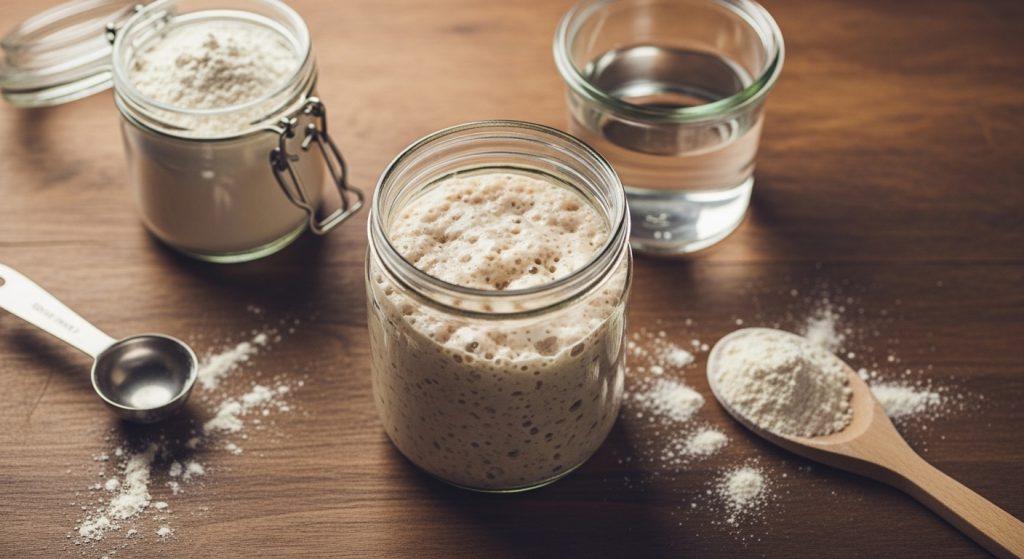
You’ll find that hydration—the ratio of water to flour in your starter—plays a vital role in how quickly fermentation happens and how lively your starter becomes.
Adjusting hydration changes the texture, from thick and doughy to loose and sticky, which directly impacts the rise and strength of your bread. Choosing the right hydration is similar to selecting an adjustable air pressure setting for precision in baking techniques.
A 100% hydration sourdough starter, with equal parts water and flour by weight, maintains a thin, pancake-like consistency that promotes active fermentation.
Mastering this balance lets you control both the activity and the final crumb of your sourdough.
Hydration Levels Explained
Understanding hydration levels in your sourdough starter reveal the key to controlling its activity and consistency.
Hydration is the water-to-flour ratio, expressed as a percentage, shaping how fluid or stiff your starter feels. Higher hydration (above 65%) creates a batter-like, more active starter, while lower hydration yields a firmer, slower-fermenting starter.
This balance impacts feeding frequency, texture, and flavor development.
| Hydration Level | Consistency | Activity Level |
|---|---|---|
| 50-65% | Stiff, dough-like | Slower fermentation |
| 66-100% | Batter-like | Faster activity |
| 100%+ | Very liquid | Most active |
Adjusting hydration lets you customize your starter’s behavior, optimizing both ease of use and bread character. The fermentation process influenced by hydration can also lower the glycemic index, making your bread more suitable for health-conscious bakers.
Impact on Fermentation Speed
How does hydration level influence the speed of fermentation in your sourdough starter? Higher hydration creates a wetter environment, allowing yeast and lactic acid bacteria to move more freely and multiply faster. This boosts acid production and accelerates fermentation, often showing up as vigorous bubbling and a creamy aroma.
Starters at 100% hydration typically ferment faster due to their fluid consistency which enhances microbial activity. Using the right tools, such as flexible and heat-resistant silicone scrapers, can help you manage your starter more efficiently during feeding and mixing.
Conversely, stiffer starters ferment slower because microorganisms struggle in drier conditions. Keep in mind, very wet starters may bubble actively but release gas too easily, masking rise speed as a fermentation sign.
Also, the microbial community adapts to hydration changes, so if you switch from high to low hydration, the fermentation traits persist, impacting speed.
Ultimately, hydration plays a pivotal role in how quickly and robustly your starter ferments, giving you control over timing and flavor development.
Texture and Rise Effects
Hydration doesn’t just influence fermentation speed—it also shapes the texture of your starter and the rise of your dough. Higher hydration starters have a batter-like consistency, making them easier to stir and incorporate smoothly into dough.
This fluidity promotes vigorous fermentation, encouraging a more open crumb with larger air pockets and a lighter texture. In contrast, stiff starters feel dough-like and can be tougher to mix, slowing fermentation and resulting in denser bread with a tighter crumb. Sourdough discard can also be creatively used in recipes such as pancakes and waffles, adding versatility to your baking routine.
Starters around 100% hydration strike a balance, supporting effective rise within about eight hours under typical conditions. Understanding the ratio of water to flour in your starter is essential for achieving consistent dough behavior and bread quality.
Microbial Dynamics in Sourdough Fermentation
When you plunge into sourdough fermentation, you’ll discover a vibrant microbial world where bacteria and yeasts interact in a finely tuned dance. Lactic acid bacteria (LAB) and yeasts dominate this ecosystem, with LAB outnumbering yeast 100 to 1, producing acids that shape flavor and texture. Each starter sample contains a median of 7 bacterial and 35 fungal ASVs, reflecting an impressive microbial diversity that contributes to fermentation.
Early on, a diverse microbial crowd from flour competes. But acid-tolerant Lactobacillus species swiftly take over, forming a stable community through metabolic cooperation with yeasts. This symbiosis fuels dough rise as yeasts release carbon dioxide while bacteria ferment sugars anaerobically, enhancing nutrient absorption and bread digestibility.
Environmental factors like temperature and pH finely tune which microbes thrive, ensuring your starter’s microbial dynamics remain balanced.
How to Feed and Maintain an Active Starter?
Since a sourdough starter thrives on regular care, feeding it properly is key to keeping the microbial community vibrant and balanced. You’ll want to discard part of your starter before feeding to avoid overgrowth and maintain a manageable amount.
Stick to a typical 1:4:4 ratio of starter, water, and flour—using unbleached, unbromated flour, occasionally with rye to boost strength. Use chlorine-free, room-temperature water and mix thoroughly until smooth for even fermentation. All-purpose flour is a popular choice because it supports yeast and bacteria with its balanced protein and carbohydrate content, providing consistent fermentation.
Remember these essentials:
- Feed daily at room temperature or weekly if refrigerated, warming before use.
- Use a glass jar with a loose cover to promote airflow but prevent contamination.
- Track rise with a rubber band and perform float tests to gauge readiness.
- Maintaining a regular feeding schedule is crucial to keep the starter active and healthy.
Effects of Temperature and Environment on Starter Performance
Although your sourdough starter can survive across a range of temperatures, keeping it within the ideal 74–86°F range is essential for vibrant microbial activity and predictable fermentation.
Within 76–80°F, yeast and bacteria thrive, producing consistent rises and balanced acidity. Maintaining cleanliness during feedings also helps prevent mold growth that could disrupt this balance.
Temperatures below 68°F slow fermentation drastically, leading to denser bread, while above 90°F, fermentation speeds up too much, risking sourness and weak gluten.
Because yeast dies at temperatures above 120°F, and water above 100°F can kill yeast, it is important to monitor water temperature when feeding your starter.
Environmental factors matter, too—you’ll notice starters thin and overly hungry in summer heat but sluggish in cooler rooms or the fridge.
To maintain starter vitality, adjust water temperature or reduce starter amounts during warm spells.
Synchronizing your starter’s temperature with dough fermentation enhances rise speed and flavor control, letting you coax the best performance from your starter regardless of your kitchen’s climate.
Identifying the Peak Activity Phase
You’ll know your starter is at peak activity when it doubles in volume and forms a domed surface, signaling maximum yeast and bacterial action. Timing this rise—usually between 4 to 6 hours after feeding—is key to catching the starter at its most potent.
This peak corresponds to the end of the exponential phase in the bacterial growth curve, where metabolic activity is at its highest. Pay close attention to the aroma shift from sweet to a vibrant, fruity, and slightly acidic scent, which reveals the perfect moment to bake. Using a bubbly sourdough starter ensures optimal fermentation and flavor development in your bread.
Visual Signs of Peak
When your sourdough starter reaches its peak activity, you’ll notice a lively display of bubbles forming on its surface and clinging to the jar’s sides—clear signs that yeast and bacteria are vigorously fermenting and producing carbon dioxide.
The starter’s texture becomes light, airy, and slightly stretchy, showing excellent gas retention. You might also see the surface dome slightly, indicating maximum gas buildup before it begins to collapse. These visual cues confirm your starter’s vitality and readiness for baking. A consistent rise over multiple feedings further signals a healthy and active starter.
Key visual signs to watch for include:
- Abundant bubbles on the surface and within the starter’s body
- A domed, puffed-up surface signaling peak fermentation
- A fluffy, smooth consistency with no crust or separation
Timing the Peak Rise
Because the timing of your sourdough starter’s peak activity directly impacts your bread’s rise and flavor, learning to identify this phase is essential. Typically, peak rise happens 2 to 4 hours after feeding at room temperature, but factors like feeding ratio and ambient temperature can extend this to 6-12 hours or more. Yeast cells consume carbohydrates in flour, producing carbon dioxide and ethanol during alcoholic fermentation.
By marking your jar at feeding and tracking volume increases, you’ll pinpoint when your starter reaches its maximum height—usually staying at peak for 1 to 2 hours before declining.
Consistent feeding schedules train your starter to peak predictably, letting you plan baking precisely.
Understanding these timing nuances ensures you harness maximal yeast activity, guaranteeing your dough ferments ideally for that perfect rise and depth of flavor every time you bake.
Aroma Changes Indicating Peak
Although volume and texture give essential clues, the aroma of your sourdough starter offers an equally powerful signal of its peak activity. As your starter nears its prime, expect a pleasant, slightly tangy scent evolving from sweet flour to a mild, fermented acidity.
A yeasty, alcoholic note often emerges, indicating vigorous yeast fermentation. These aroma shifts align with visible bubbles and a light, airy texture, confirming the starter’s vitality. The type of flour can affect these sensory cues, as whole wheat or rye starters might have a stronger or earthier aroma than those made with white flour. Trust your senses: off-putting vinegar or foul odors mean the starter is past peak or unhealthy.
- Pleasant tangy and yeasty aromas mark peak vitality
- Frothy bubbles correlate with intensified fermentation scents
- Avoid strong vinegar or foul smells signaling decline
Differences Between Liquid and Stiff Starters
While both liquid and stiff sourdough starters serve as the essential foundation for bread-making, you’ll find they differ considerably in hydration, fermentation behavior, and handling.
Stiff starters are thick and dough-like with about 50%-80% hydration, fermenting slowly and lending a milder acidity. They boost yeast activity over bacteria, which contributes to a more stable and happy starter. Liquid starters, often at 100% hydration or more, are batter-like, ferment quickly, and yield a tangier flavor.
Handling varies too—stiff starters require kneading, while liquid starters need just stirring. Here’s a concise comparison:
| Aspect | Stiff Starter |
|---|---|
| Hydration | 50%-80%, dough-like |
| Fermentation | Slower, lactic acid dominant |
| Handling | Kneading during feeding |
| Flavor Impact | Milder, sweeter acidity |
| Aspect | Liquid Starter |
| Hydration | 100%+, batter-like |
| Fermentation | Faster, acetic acid dominant |
| Handling | Stirring only |
| Flavor Impact | Stronger, tangier acidity |
Importance of Active Starter in Bread Baking
You want your sourdough starter at its peak fermentation to maximize gas production and guarantee your dough rises beautifully.
Timing is everything—catching the starter when it’s bubbling and doubling in size means the yeast is most active, creating the perfect environment for leavening. An active starter is typically fed within 4-12 hours and shows visible bubbles and volume increase, indicating the highest level of yeast and bacteria activity.
Missing this window can lead to weaker rises and less flavorful bread, so tracking your starter’s activity is vital for consistent baking success.
Peak Fermentation Timing
When you catch your sourdough starter at its peak fermentation, usually between 2 to 4 hours after feeding under ideal conditions, you release its full leavening power.
At this stage, the starter has doubled in volume and formed a domed top, signaling maximum yeast activity.
Using it right at peak ensures your dough rises beautifully with excellent flavor and texture. Timing varies with temperature, flour type, and feeding ratio, so observe and mark your starter’s rise to master your schedule.
Remember these key signs of peak fermentation:
- Volume doubled with a domed, bubbly surface
- Aroma shifts from sweet to a tangy, sour fragrance
- Predictable peak time helps plan your baking rhythm
It is important to note that many websites, including those like Sourdough Explained, emphasize user consent regarding cookies to ensure the best experience.
Nailing peak timing transforms your baking from good to exceptional.
Optimal Gas Production
Because gas production drives the rise and texture of your sourdough bread, maintaining an active starter is essential for baking success. Your starter’s yeast ferments sugars, producing CO2 that gets trapped in the gluten network, creating the air bubbles that give bread its volume and open crumb.
To optimize gas output, keep your starter at 74-76°F and feed it whole grain flours at peak ripeness—both fuel vigorous fermentation. Using a non-reactive container such as glass or food-grade plastic can help maintain starter health by preventing contamination.
Watch for bubbling and a noticeable rise and fall cycle; these signals indicate healthy microbial activity.
If gas production wanes, your starter’s leavening power diminishes, leading to dense, flat loaves.
Troubleshooting Common Starter Activity Issues
Although maintaining a lively sourdough starter can sometimes feel unpredictable, understanding the common signs of low activity empowers you to intervene effectively.
If your starter develops a hooch layer, emits an alcohol-like smell, or shows minimal bubbles and rising, it’s signaling distress. These clues mean the yeast and bacteria need more nourishment or better conditions. Hooch is a harmless byproduct that forms when the microbes have run out of food, often after neglect or rapid feeding.
To restore vigor, consider these key steps:
- Increase feeding frequency to every 8–10 hours, discarding half before each feeding to balance acidity.
- Maintain a warm environment around 74-76°F (23-24°C) and use filtered water to protect microbes.
- Use feeding ratios like 1:8:5 (starter:flour:water) and incorporate whole grain flours to boost microbial activity.
Frequently Asked Questions
Can I Use Fruit Juice Instead of Water to Feed My Starter?
You can use fruit juice instead of water to feed your starter, especially in the first few days. The acidity in juices like pineapple helps prevent unwanted bacteria, creating a healthier environment for your starter’s natural yeasts.
Just remember to switch back to water after those initial feedings to maintain balance. Fresh, unsweetened juice works best, and avoid preservatives that might harm your starter’s delicate microbial community.
How Do I Travel With My Sourdough Starter Safely?
When traveling with your sourdough starter, dehydrate it several days ahead for mess-free transport or vacuum seal dried starter in checked luggage.
If carrying liquid starter on a plane, reduce to 25-50g and feed 12 hours prior. Keep the container loosely sealed until departure, then tighten and place inside a zip-lock bag.
For car trips, keep starter cool in a jar, avoid feeding just before travel, and carry a backup to prevent loss.
What Containers Are Best for Storing Sourdough Starters?
Choosing the perfect container for your sourdough starter means picking a clear, clean, and convenient vessel. Glass jars grab great attention since they’re non-reactive and transparent, letting you track bubbling activity.
Aim for medium-sized containers around 28 ounces with wide mouths for easy stirring. Loosely fitting lids let gases gently escape without building pressure. Avoid airtight traps to keep your starter safe and spirited, ensuring consistent, lively fermentation every time.
Can I Mix Different Flours in My Starter Feedings?
Absolutely, you can mix different flours when feeding your starter! Combining wheat, rye, or whole grain flours adds complexity to flavor and boosts microbial diversity.
Just keep in mind, rye flour ferments faster and may require hydration tweaks. Gradually switch flours to help your starter adapt smoothly without stress.
Experimenting with blends gives you a vibrant, resilient starter that enhances your sourdough’s character and performance beautifully.
How Long Can I Store a Starter in the Refrigerator Without Feeding?
Think of your sourdough starter like a sleeping dragon; it can stay dormant but needs occasional awakening. You can store it in the fridge without feeding for up to three weeks safely.
Beyond that, the risk of weakening or off smells grows. Feeding before refrigeration and weekly checks keep it lively.
If you plan longer breaks, consider drying it—this way, your starter will rise from slumber ready to roar again.
Discover the Joy of Baking with a Thriving Starter
Just like a well-tuned orchestra, your active sourdough starter brings harmony to every loaf you bake. It’s the living heartbeat of your bread, a delicate balance of microbes and hydration that transforms simple ingredients into art.
By understanding and nurturing its rhythms, you reveal flavors that echo centuries of tradition. Keep feeding, observing, and trusting this vibrant culture—your hands hold the key to timeless, soulful bread-making mastery.

